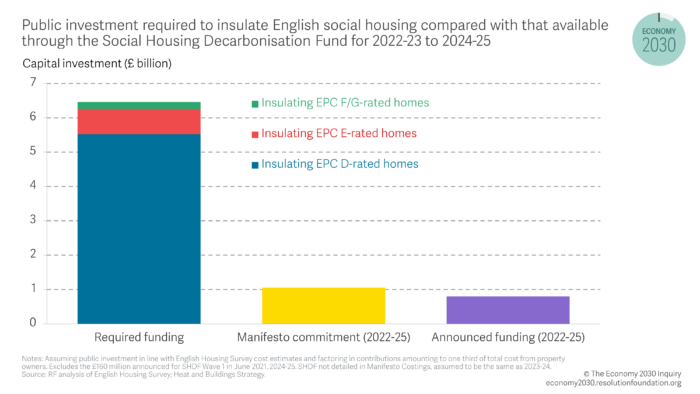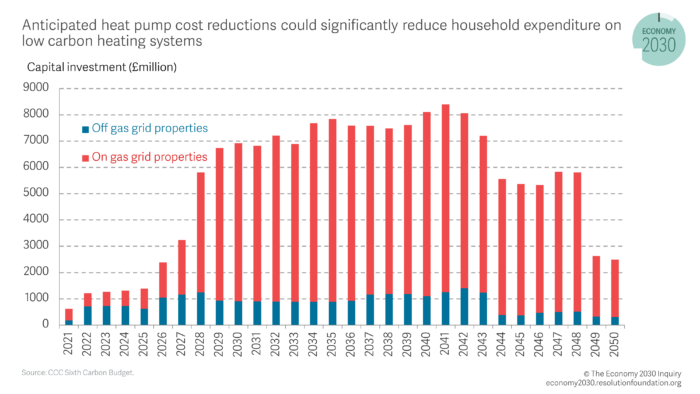Home is where the heat (pump) is

The Government’s recently released Heat and Buildings Strategy represents a much-needed step forward in plans to decarbonise Britain’s homes, a task likely to be one of the trickiest aspects of reaching net zero emissions. While much of the headlines have focused on heat pumps, the strategy contains welcome support for insulating social housing and the properties of some other low-income households. However, there are gaps in support for owner occupiers on lower incomes, especially those in homes connected to the gas grid. The focus on market-based measures such as green mortgages at the expense of greater capital funding from government also represents a strategic choice, one that the history of delivering similar policies shows may not work in the best interest of low-income households.
A proposed target for all private-rented homes to reach an EPC-C rating by 2028 is welcome and should mean the benefits of cheaper-to-heat homes are spread to private renters. This is important because it affects one-in-five low-income families. But these new regulations will need to be enforced, in a sector without a strong track record.
The Government has also delivered much-needed clarity on the future of low carbon heating, signalling that heat pumps will keep the majority of Brits warm in the decades to come. If successful, a new support package targeted at delivering cost reductions through industry should cut the cost of replacing gas boilers with heat pumps by as much as half. Delivering the ambition for heat pumps to reach cost parity with gas boilers by 2030 is vital to boosting the affordability of the transition, and in reaching the Government’s target of installing 600,000 heat pumps per year by 2028. The funding set out in the Strategy, however, will only fund 90,000 heat pump installations over three years.
Overall, then, the Government’s Heat and Buildings Strategy should prove a key step forward in improving the energy efficiency of Britain’s housing stock and moving to cleaner sources of heat, a task given new impetus by the recent gas-price spike. But more policy will surely be needed to ensure that the benefits of low-carbon homes are available to all.
The writing is finally on the wall for Britain’s gas boilers with the Government this week announcing that they have ‘no long-term role in a low-carbon future’. The aim is to phase out new boiler installations by 2035, signalling the start of one of the most challenging and disruptive aspects of the net zero transition – how we decarbonise our homes.
The Government’s approach to this journey is set out in the long-awaited Heat and Buildings Strategy (HBS), released this week after years of delay. The headlines were made by promises of grants for heat pumps, an (almost) ban on installing gas boilers from 2035, and slightly more certainty on home insulation. The Government says it now expects the average energy bill to be lower in 2024 as a result of its proposals. So, what does all this mean for households, particularly those on lower incomes? This boils down to two main areas: how Government will support the cost of insulating homes (part of a broader question of how we fund upfront capital costs of change), and how the cost of low-carbon heat sources – specifically heat pumps – can be reduced rapidly enough to enable the widespread uptake needed to meet our carbon targets.
Although the focus on households in need of financial assistance is welcome, it is clear that the level of ambition is too low
A key requirement of the HBS was detailing how the £9.2 billion of public cash for insulation pledged in the 2019 Conservative manifesto is going to be spent. This pledge contained £3.8 billion earmarked for a ten-year scheme to upgrade social housing (the Social Housing Decarbonisation Fund) and £2.5 billion for Home Upgrades Grants, a five-year programme to insulate and change heating sources for low-income households in the least efficient, off-gas-grid homes.
With the upcoming three-year Spending Review surely in mind, funding for these schemes over the years 2022-23 to 2024-25 has been announced. Additional investment on top of the £1.75 billion of new funding announced for housing upgrades in the HBS (of which £950 million will fund Home Upgrades Grants and £800 million is for decarbonising social homes), and also that detailed in the 2020 Spending Review, will be needed to meet the pledged £2.5bn for Home Upgrades Grants. In addition, the second five years of the decade-long Social Housing Decarbonisation Fund will need to do most of the heavy lifting if it is to deliver on the ambition outlined in the manifesto. Speaking in the House of Commons after the release of the Strategy, Energy Minister Greg Hands confirmed that the original £2.5 billion of funding would be available for Home Upgrade Grants and that the programme could potentially be extended to 2030. But additional clarity will be needed on how this squares with investment decisions detailed in the HBS.
More funding will also be needed to make social homes more efficient. This is important because nearly three-in-ten (29 per cent) of households in the lowest income quintile live in either local authority or housing association properties, and so stand to benefit the most from better-quality homes.[i] The focus on social housing thus far is most welcome because around 1.6 million social homes have a poor energy rating (below Energy Performance Certificate Band C), but pledges made to date will not be sufficient to improve all of these properties.
The first phase of Social Housing Decarbonisation Fund has a per-property cap on the level of state contribution of £10,000 for an EPC-D rated home, rising to £16,000 for an EPC F/G rated home. It is likely that in most cases improvements will cost less. Taking the average cost for upgrading a social sector home from EPC D to EPC C and applying to each of the 1.4 million EPC-D-rated social homes would lead to a taxpayer bill of £5.5 billion, with the 190,000 or so E to G rated homes requiring a further £950 million of public investment.[ii] Remedying this will need significant additional capital investment, as shown in Figure 1, spread over sufficient time to avoid overwhelming local authorities and housing associations.
Figure 1: Government support for decarbonising social housing falls short of what is needed

The recent energy price spike highlighted the benefits of efficient housing, with analysis concluding that the October price cap increase is likely to push up gas bills for a household in an EPC-D-rated home by £107 more than one in an EPC-C-rated equivalent.
If enforced, tough new targets will help private renters
The HBS included ambitious targets for landlords to improve rental properties that could bring welcome relief for those in the private-rented sector (PRS), a tenure that houses one-fifth (21 per cent) of the poorest households.[iii] The poor energy performance of these properties is not new; nor is a lack of improvement over time (as Figure 2 shows), with previous attempts to introduce minimum efficiency standards on landlords watered down by the inclusion of a £3,500 maximum spend limit on improvements. Around 60 per cent of homes in the PRS are wasting more energy than they need to – that is, they are rated below EPC C. Plans to ensure that all new lets in 2025 are for EPC-C-rated (or above) homes, and all rented homes are EPC-C-rated by 2028 will see many of the least efficient properties in the country upgraded, assuming that these standards are enforced effectively. That is, however, a big if for a sector with a poor track record of enforcing such standards.
Figure 2: The proportion of inefficient homes in the PRS remains stubbornly high

Obliging landlords to improve their properties should mean a significant number of homes improved without costs to the public purse, fitting with the OBR’s central case projections that assume property owners contribute 56 per cent of the total cost of decarbonising the housing stock. The impacts on the housing market, both in terms of landlords potentially exiting the market, or attempting to pass costs on to renters, will become clear over time.
There is a big gap in support for owner-occupiers, particularly those on lower incomes
Approximately two-thirds of homes in England are owner-occupied, a tenure category for which plans in the Heat and Buildings Strategy provide minimal support. This is important because there are a significant number of households lower down the spectrum who own their homes with a mortgage.[iv] So it is vital that this group is not overlooked.
In the absence of a replacement for the Green Homes Grant, the Government is leaning on market-based tools such as ‘green mortgages’ which offer lower rates or additional loans to families wanting to upgrade their homes. Only around one-third (35 per cent) of homes owned with a mortgage are rated EPC-C or higher,[v] leaving the majority without directly-funded support for improving efficiency.
This is a problem because lower-income households are less likely to be able to afford the improvements themselves. Families in this group who have been able to step onto the housing ladder, particularly younger families, are likely to have more debt, and so be less willing or able to extend loans to undertake building upgrades. Indeed, a recent survey found that more than one-in-ten mortgagees entered the pandemic with no savings, with many now facing higher payments to make up time on mortgage holidays during the pandemic.
The Government has staked the future of clean heat on drastic reductions in the cost of heat pumps – it is now down to industry to deliver
Leading news coverage of the Strategy was a new £450 million fund for heat pump grants. These grants are seen as a vital part of achieving the Government’s goal of reducing the cost of a heat pump by between a quarter and a half by 2025, before reaching cost parity with gas boilers by 2030. The Government has pinned its hopes of decarbonising heat in an affordable way on rapid reductions in the cost of heat pumps. But it will be down to the industry to deliver on this.
These are laudable goals that – if successful – will drastically reduce the overall cost of the net zero transition. Modelling for the CCC assumes an air source heat pump will still cost £5,000 in 2035, and that household investment in low carbon heat over the next three decades will run to £162 billion (see Figure 3). If the cost-reduction targets outlined in the HBS are achieved, this could cut this in half; cheaper technology will benefit everyone.
Figure 3: Anticipated heat pump cost reductions could significantly reduce household expenditure on low carbon heating systems

Achieving the anticipated cost reductions via a relatively small financial package would be an excellent example of effective and targeted use of subsidies. In fact, it is crucial in doing so to ensure the right distributional outcome, given that higher-income households are more likely to benefit from initial state support.
History suggests that lower income households are less likely to take advantage of grant schemes than those higher up the income spectrum. Indeed, HM Treasury analysis suggests that grant support for electric vehicles has flowed towards richer families, while state backing for small scale renewables and clean heat schemes have also generally resulted in installations in the homes of the wealthy. Attempts to remedy this by means-testing the grants, thereby covering more or all of the cost of heat pumps installations for lower income households would have been more inclusive.[vi]
Key tests for this policy will be whether it brings about enough installations to get on track to achieve the Government’s self-imposed goal of installing 600,000 heat pumps per year by 2028, and also whether it is successful in bringing down the upfront costs faced by households. Only time will tell if this is the case.
Conclusion
The poor state of Britain’s housing stock has been long known, with the imperative for improvement hastened by the recent gas price spike. In this context, the Government’s Heat and Buildings Strategy is a big step forward. Particularly welcome is the focus of policies towards lower-income households. But more funding and policy certainty will be needed to ensure that the costs of decarbonising tens of millions of homes do not land unfairly, and that the benefits of low carbon homes – including lower running costs, reduced air pollution and more pleasant living conditions – are available to all.
[i] Figures based on RF analysis of ONS, English Housing Survey, 2018.
[ii] Funding caps in Phase One of the Social Housing Decarbonisation Fund. Average costs calculated in line with ONS estimates for social sector homes with two thirds of capital provided by Government and one third by property owners.
[iii] Figures based on RF analysis of ONS, English Housing Survey, 2018.
[iv] Figures based on RF analysis of ONS, English Housing Survey, 2018.
[v] English Housing Survey data shows 34.9 per cent of mortgaged properties with an EPC rating of A-C, 51.2 per cent rated D and 13.8 per cent E or below.
[vi] It is worth noting that low income households are not completely cut off from support for heat pumps, with funding available through the Social Housing Decarbonisation Fund and through Home Upgrades Grants, although uptake through these schemes will likely be lower than through a programme focussed solely on heat pumps.